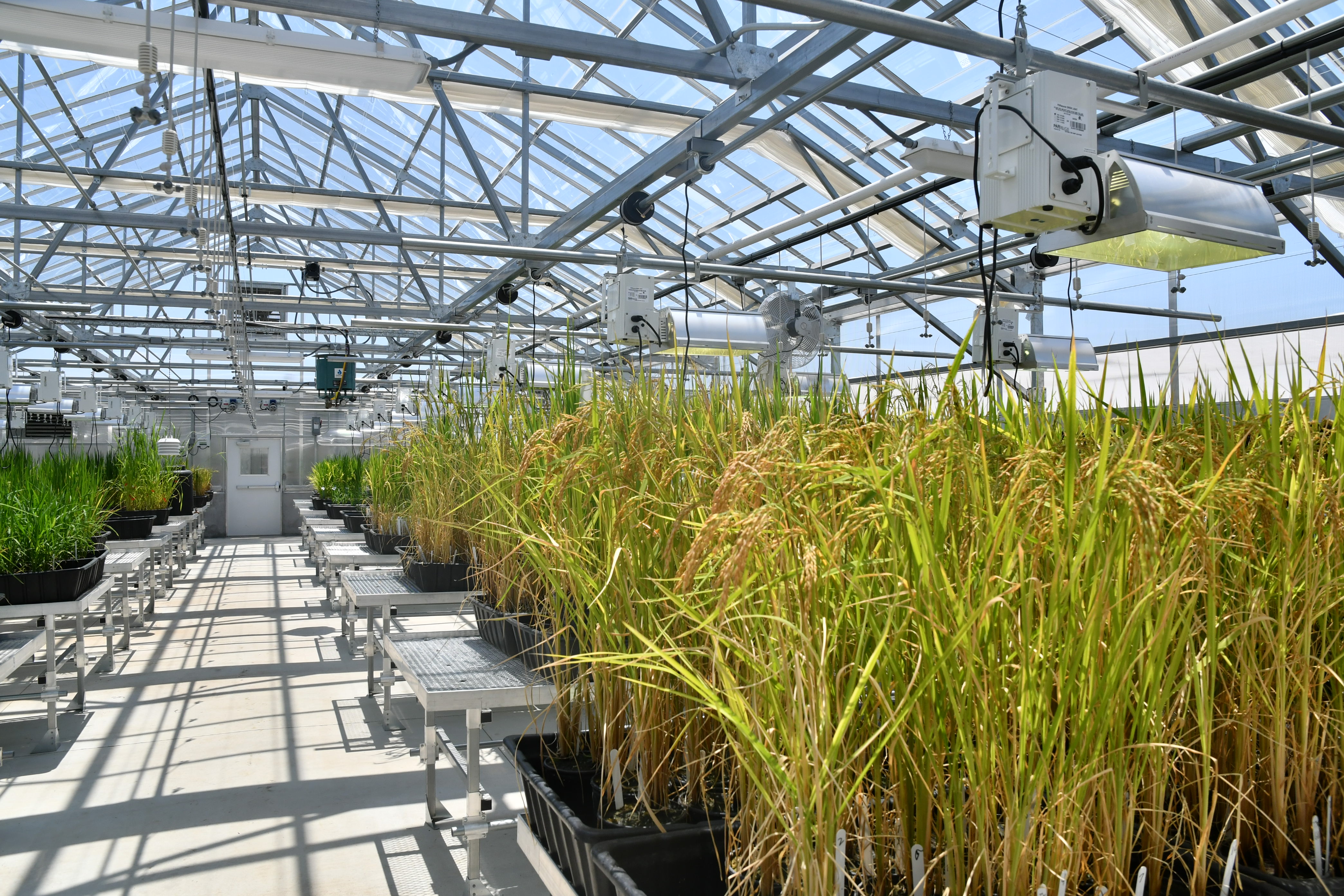Advanced greenhouse will amp up rice research in Stuttgart
Aug. 2, 2018
By Sarah Cato
U of A System Division of Agriculture
Fast facts:
- New greenhouse and growth chambers added to the Rice Research and Extension Center in Stuttgart
- Facilities will enable hybrid rice breeding program and selection of rice lines for tolerance to high nighttime temperatures
- $1.88 million cost fully funded by Arkansas Rice Research and Promotion Board.
(542 words)
(newsrooms: with art at https://flic.kr/s/aHskFzdMKf )
Download Word version
STUTTGART, Ark. – A research greenhouse formally opened Thursday further enables efforts by University of Arkansas System Division of Agriculture to stem rice yield loss after milling due to high nighttime temperatures.
Jay Coker, Chairman of the Rice Research and Promotion Board, said the need for an advanced facility to help develop resilient rice varieties became apparent after Arkansas rice producers lost yield after milling due to high nighttime temperatures in 2016. (See background on this issue: http://bit.ly/2O1I9Gf)

“The greenhouse and growth chambers projects are both an immediate and direct response to the impact of high nighttime temperatures that negatively impacted rice growers in 2016,” Coker said. “This investment of research funds will allow researchers to overcome these issues and bring higher yielding and better quality rice varieties in an expedited manner into the hands of the Arkansas rice grower.”
The Rice Research and Promotion Board fully funded the $1.88 million cost for the research greenhouse and growth chambers.
Eshan Shakiba, a rice breeder for the University of Arkansas System Division of Agriculture, said the growth chambers and rest of the greenhouse are digitally controlled, enabling researchers to precisely create whatever environment is needed for research. Researchers can control temperature, light intensity, humidity, carbon dioxide levels, length of day and other factors as needed for variety testing, as well as being alerted should something go awry. A reverse osmosis system ensures pure water for plant growth.
These new programs also keep data readily available for researchers.
“These facilities are unique in our region in that they are controlled by a computer. It has a sophisticated system for moisture, light and heat control,” Shakiba said. “If something happens it can notify us via Bluetooth. Also, it is all connected to the internet, so we can take data from the computer and put that information on a flash drive if needed.”
The 40 by 80-foot greenhouse will be used to breed hybrid and conventional rice that is tolerant to high nighttime temperatures. Greenhouse will be used primarily for hybrid rice breeding activities. The 10- by 20-foot growth chambers will be used for screening hybrid and conventional rice lines for tolerance to high nighttime temperatures.
Along with advanced technology, the growth chambers also offer researchers the space they need to test the 72 different cultivars in the high nighttime temperatures study.
“Most growth chambers are small, like closets,” Shakiba said, “But we needed something to test multiple cultivars simultaneously in different conditions.”
Jean-Francois Meullenet, associate vice president for agriculture research, said the new facilities are in good hands with the rice breeders at the Rice Research and Extension Center.
“The Arkansas Rice Research and Promotion Board have been very supportive of our research, and it’s comforting to know that their dollars are being put to good use,” Meullenet said. “This research will, in time, have a great impact on our rice growers.”
The project has been a group effort between Division of Agriculture rice breeders, University of Arkansas scientists and administrators, architects and the Rice Promotion Board. Shakiba said seeing all of their hard work come to fruition has been greatly satisfying.
“We traveled and spoke with people across the state and in other states to ask questions about their greenhouses. We asked about what worked and what didn’t,” Shakiba said. “We worked very hard on this and we are very proud of it.”
For more information on rice research in Arkansas visit https://www.uaex.uada.edu/media-resources/ArkansasRicePeakPerformance/.
About the Division of Agriculture
The University of Arkansas System Division of Agriculture’s mission is to strengthen agriculture, communities, and families by connecting trusted research to the adoption of best practices. Through the Agricultural Experiment Station and the Cooperative Extension Service, the Division of Agriculture conducts research and extension work within the nation’s historic land grant education system.
The Division of Agriculture is one of 20 entities within the University of Arkansas System. It has offices in all 75 counties in Arkansas and faculty on five system campuses.
Pursuant to 7 CFR § 15.3, the University of Arkansas System Division of Agriculture offers all its Extension and Research programs and services (including employment) without regard to race, color, sex, national origin, religion, age, disability, marital or veteran status, genetic information, sexual preference, pregnancy or any other legally protected status, and is an equal opportunity institution.
# # #
By Mary Hightower
The Cooperative Extension Service
U of A System Division of Agriculture
Media Contact: Mary Hightower
Dir. of Communication Services
U of A Division of Agriculture
Cooperative Extension Service
(501) 671-2126
mhightower@uada.edu
Related Links